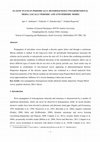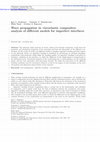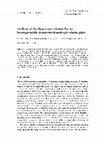Papers by Graham Rogerson

Journal of Mechanics of Materials and Structures, 2008
Long wave dispersion in an incompressible elastic layer subject to an initial static simple shear... more Long wave dispersion in an incompressible elastic layer subject to an initial static simple shear deformation is investigated. Long wave approximations of the dispersion relation associated with zero incremental traction on the faces are derived for both low and high-frequency motion. Comparison of approximate and numerical solutions is shown to provide excellent agreement over a surprisingly large wave number range. Within both the low and high-frequency regimes, the approximations are employed to establish the relative asymptotic orders of the displacement components and hydrostatic pressure. In the high-frequency case, the in-plane component of displacement is shown to be asymptotically larger than the normal component; motion is, therefore, essentially that of thickness shear resonance. The influence of this specific form of initial deformation is, therefore, seemingly minor in respect of longwave high-frequency motion. However, in the long-wave low-frequency case, considerable differences are noted in comparison with both the classical and previously published prestressed cases. Specifically, both the normal and in-plane displacement components are of the same asymptotic order, indicating the absence of any natural analogue of either classical bending or extension.
A two-dimensional model describing the equilibrium state of a cracked inhomogeneous body with a r... more A two-dimensional model describing the equilibrium state of a cracked inhomogeneous body with a rigid circular inclusion is investigated. The body is assumed to have a crack that reaches the boundary of the rigid inclusion. We assume that the Signorini condition, ensuring non-penetration of the crack faces, is satisfied. We analyze the dependence of solutions on the radius of rigid inclusion. The existence of a solution of the optimal control problem is proven. For this problem, a cost functional is defined by an arbitrary continuous functional, with the radius of inclusion chosen as the control parameter.

The phononic band structure of waves, which travel though composites, results from the geometric ... more The phononic band structure of waves, which travel though composites, results from the geometric and mechanical properties of the materials and from the interaction of the different constituents. In this article, we study two different models to simulate imperfect bonding and their impact on the phononic bands: (a) imperfect bonding is simulated by introducing an artificial interphase constituent with properties which define the bonding quality; (b) imperfect bonding is described by conjugate conditions in the interface, in which the difference in the displacement is proportional to the interfacial stress. Viscoelastic behavior of the constituents has a crucial influence on the traveling signal, and the wave attenuates with increasing viscosity. We study the interaction of the different bonding conditions and the viscoelastic behavior as well as the impact of such interplay on the wave attenuation and dispersion characteristics of the material.

It is well known that an elastic material subject to N (0 ⩽ N ⩽ 3), internal constraints upon the... more It is well known that an elastic material subject to N (0 ⩽ N ⩽ 3), internal constraints upon the deformation gradient admits the propagation of 3 — N distinct plane waves in most directions. Those directions in which more than 3 — N waves may propagate are termed exceptional . Here we investigate wave propagation in a material subject to two constraints by slightly relaxing both constraints and asymptotically expanding the wave speeds and the polarizations in inverse powers of the large elastic moduli associated with the slightly relaxed constraints. The limits in which (1) both constraints operate exactly, and (2) one constraint is exact and one slightly relaxed are both discussed and shown to confirm previous results. The theory and graphical illustrations of the slowness surface are presented for two examples of a practical nature: (1) an incompressible material reinforced by a set of parallel inextensible fibres; (2) a material reinforced by two sets of mutually orthogonal inex...

Proceedings of the Royal Society A: Mathematical, Physical and Engineering Sciences
We aim to study how the interplay between the effects of nonlinearity and heterogeneity can influ... more We aim to study how the interplay between the effects of nonlinearity and heterogeneity can influence on the distribution and localization of energy in discrete lattice-type structures. As the classical example, vibrations of a cubically nonlinear elastic lattice are considered. In contrast with many other authors, who dealt with infinite and periodic lattices, we examine a finite-size model. Supposing the length of the lattice to be much larger than the distance between the particles, continuous macroscopic equations suitable to describe both low- and high-frequency motions are derived. Acoustic and optical vibrations are studied asymptotically by the method of multiple time scales. For numerical simulations, the Runge–Kutta fourth-order method is employed. Internal resonances and energy exchange between the vibrating modes are predicted and analysed. It is shown that the decrease in the number of particles restricts energy transfers to higher-order modes and prevents the equiparti...

International Journal of Engineering Science
A two-scale methodology to calculate the local stress-strain state (SSS) in structures composed o... more A two-scale methodology to calculate the local stress-strain state (SSS) in structures composed of connected elements is proposed. The methodology is based on the assumption that the connecting unit has a size small in comparison to the objects being connected. It is demonstrated that the problem of connection allows asymptotic decomposition. At the macroscopic level (the zero order approximation), an interface problem, with appropriate interface conditions, is revealed. At this order, the individual properties of the joint are neglected. These properties manifest themselves at the next asymptotic order, which takes into account all individual joint properties using the solution of the macroscopic problem. The local SSS in the vicinity of joint consists of the SSS in the connecting unit, together with rapidly decaying boundary layers in the connected elements. A detail elucidation of the local SSS in the connecting unit is an important distinction of this work from previous studies of connected structures. Motivated by the asymptotic analysis, a numerical method for simultaneously calculating the SSS in both the connected structures and the connecting unit is developed. An illustrative example, involving computation of the SSS in the vicinity of an explosion welding seam, is presented.

Proceedings of the Royal Society A: Mathematical, Physical and Engineering Sciences
Propagation of anti-plane waves through a discrete square lattice and through a continuous fibrou... more Propagation of anti-plane waves through a discrete square lattice and through a continuous fibrous medium is studied. In the long-wave limit, for periodically heterogeneous structures the solution can be periodic or anti-periodic across the unit cell. It is shown that combining periodicity and anti-periodicity conditions in different directions of the translational symmetry allows one to detect different types of modes that do not arise in the purely periodic case. Such modes may be interpreted as counterparts of non-classical waves appearing in phenomenological theories. Dispersion diagrams of the discrete square lattice are evaluated in a closed analytical from. Dispersion properties of the fibrous medium are determined using Floquet–Bloch theory and Fourier series approximations. Influence of a viscous damping is taken into account.
Journal of Sound and Vibration
The aim of the paper is to study how the viscous damping influences on modes coupling in non-line... more The aim of the paper is to study how the viscous damping influences on modes coupling in non-linear vibrations of microstructured solids. As an illustrative example, natural longitudinal vibrations of a layered heterogeneous medium are considered. The macroscopic dynamic equation is obtained by the asymptotic homogenisation method. The input continuous problem is analysed using a spatial discretisation procedure. An asymptotic solution is developed by the method of multiple time scales and the fourth-order Runge-Kutta method is employed for numerical simulations. Internal resonances and energy transfers between the vibrating modes are predicted and analysed. The conditions for a possible truncation of the original infinite system are discussed. The obtained numerical and analytical results are in good agreement.
Zeitschrift für angewandte Mathematik und Physik
ABSTRACT An investigation of harmonic wave propagation in an idealised bre-reinforced layer is ca... more ABSTRACT An investigation of harmonic wave propagation in an idealised bre-reinforced layer is carried out in respect of the most general appropriate strain energy function and for propaga- tion along a non-principal direction. The dispersion relation, giving phase speed as an implicit function of wave number, associated with incremental traction free boundary conditions is derived and decomposed into flexural and extensional motions. Some conditions for the existence of sur- face waves are derived, such a wave speed being the high wave number limit of both fundamental modes. As regards the harmonics, two distinct cases are observed numerically. For both cases asymptotic high wave number expansions are derived which oer an excellent approximation to the numerical solution in the moderate and high wave number region.
International Journal of Solids and Structures
International Journal of Solids and Structures
International Journal of Non-Linear Mechanics

Acta Mechanica, 2016
The phononic band structure of waves, which travel though composites, result from the geometric a... more The phononic band structure of waves, which travel though composites, result from the geometric and mechanical properties of the materials and from the interaction of the different constituents. In this article we study two different models to simulate imperfect bonding and their impact on the phononic bands: (a) imperfect bonding is simulated by introducing an artificial interphase constituents with properties which define the bonding quality; (b) imperfect bonding is described by boundary conditions in the interface, in which the difference in the displacement is proportional to the interfacial stress. Viscoelastic behavior of the constituents has a crucial influence on the traveling signal, and the wave attenuates with increasing viscosity. We study the interaction of the different bonding conditions and the viscoelastic behavior as well as the impact of such interplay on the wave attenuation and dispersion characteristics of the material.
Lecture Notes in Applied and Computational Mechanics, 2004
Wave Motion, Dec 1, 2009
We consider waves in layered elastic structure with arbitrary vertical dependence of parameters, ... more We consider waves in layered elastic structure with arbitrary vertical dependence of parameters, in assumption of rotation invariance of the problem. The goal is generalisation of the traditional form of the solution uðx; y; zÞ ¼ expðikxÞvðzÞ with z depth and ðx; yÞ lateral variables, to general lateral dependence. We derive a general integral representation for surface or interfacial wave field, and consider as its particular cases, waves with plane wavefronts and polynomial amplitudes and waves, showing Gaussian-type localisation with respect to ðx; yÞ. We mention a possibility of surface and interfacial waves, inhomogeneous with respect to lateral variables.

Acta Mechanica, Feb 28, 2002
The dispersion relation associated with harmonic wave propagation in an incompressible, transvers... more The dispersion relation associated with harmonic wave propagation in an incompressible, transversely isotropic elastic plate is derived. Such a material is characterized by only three material constants, contrasting with five in the corresponding compressible case. Motivated by a numerical investigation, asymptotic expansions, giving phase speed and frequency as functions of wave number, are derived in both the long and short wave regimes. These approximations, which owing to the constitutive simplifications are readily available, are shown to provide excellent agreement with the corresponding numerical solution. It is envisaged that the detailed investigation carried out in this paper will aid numerical inversion of the transform solutions often used in impact problems. Additionally, the asymptotic investigation provides the necessary basis for future studies to derive asymptotically approximate models to describe long and short wave motion.

International Journal of Engineering Science, Dec 1, 2010
Long wave motion in a geometrically symmetric 3-layer laminated elastic structure is investigated... more Long wave motion in a geometrically symmetric 3-layer laminated elastic structure is investigated. The associated dispersion relation is established for three different boundary value problems. For all three cases, numerical solutions are presented and a long wave asymptotic analysis carried out, in each case the cutoff frequencies being shown to satisfy transcendental equations. Long wave approximations are employed to determine the asymptotic orders of the displacement components in the various long wave regimes. The asymptotic structures in a single layer plate associated with bending, extension, thickness stretch resonance and thickness shear resonance are well-known. It is shown that these structures are preserved within the multi-layer problem. This work provides the theoretical framework to generalise the above mentioned theories.
Journal of Engineering Mathematics, 2002
A 2-dimensional model is derived for anti-symmetric motion in the vicinity of the shear resonance... more A 2-dimensional model is derived for anti-symmetric motion in the vicinity of the shear resonance frequencies in a pre-stressed incompressible elastic plate. The method of asymptotic integration is used and a second order solution, for infinitesimal displacement components and incremental pressure, is obtained in terms of the long wave amplitude. The leading order hyperbolic governing equation for the long wave amplitude is observed to be not wave-like for certain pre-stressed states, with time and one of the in-plane spatial variables swapping roles. This phenomena is shown to be intimately related to the possible existence of negative group velocity at low wave number, i.e. in the vicinity of shear resonance frequencies.
International Journal of Solids and Structures, 2013

Uploads
Papers by Graham Rogerson